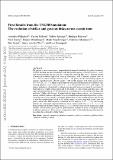First results from the TNG50 simulation: the evolution of stellar and gaseous discs across cosmic time
Author(s)
Pillepich, Annalisa; Nelson, Dylan; Springel, Volker; Pakmor, Rüdiger; Torrey, Paul; Weinberger, Rainer; Vogelsberger, Mark; Marinacci, Federico; Genel, Shy; van der Wel, Arjen; Hernquist, Lars; ... Show more Show less
DownloadAccepted version (6.263Mb)
Open Access Policy
Open Access Policy
Creative Commons Attribution-Noncommercial-Share Alike
Terms of use
Metadata
Show full item recordAbstract
We present a new cosmological, magnetohydrodynamical simulation for galaxy formation: TNG50, the third and final instalment of the IllustrisTNG project. TNG50 evolves 2 × 21603 dark matter particles and gas cells in a volume 50 comoving Mpc across. It hence reaches a numerical resolution typical of zoom-in simulations, with a baryonic element mass of 8.5 × 104 M☉ and an average cell size of 70-140 pc in the star-forming regions of galaxies. Simultaneously, TNG50 samples ∼700 (6500) galaxies with stellar masses above 1010 (108) M☉ at z = 1. Here we investigate the structural and kinematical evolution of star-forming galaxies across cosmic time (0≲ z ≲ 6). We quantify their sizes, disc heights, 3D shapes, and degree of rotational versus dispersion-supported motions as traced by rest-frame V-band light (i.e. roughly stellar mass) and by H α light (i.e. star-forming and dense gas). The unprecedented resolution of TNG50 enables us to model galaxies with sub-kpc half-light radii and with ≲300-pc disc heights. Coupled with the large-volume statistics, we characterize a diverse, redshift- and mass-dependent structural and kinematical morphological mix of galaxies all the way to early epochs. Our model predicts that for star-forming galaxies the fraction of disc-like morphologies, based on 3D stellar shapes, increases with both cosmic time and galaxy stellar mass. Gas kinematics reveal that the vast majority of 109−11.5 M☉ star-forming galaxies are rotationally supported discs for most cosmic epochs (Vrot/σ > 2-3, z ≲ 5), being dynamically hotter at earlier epochs (z ≿ 1.5). Despite large velocity dispersion at high redshift, cold and dense gas in galaxies predominantly arranges in disky or elongated shapes at all times and masses; these gaseous components exhibit rotationally dominated motions far exceeding the collisionless stellar bodies.
Date issued
2019-09Department
MIT Kavli Institute for Astrophysics and Space ResearchJournal
Monthly Notices of the Royal Astronomical Society
Publisher
Oxford University Press (OUP)
Citation
Pillepich, Annalisa et al. "First results from the TNG50 simulation: the evolution of stellar and gaseous discs across cosmic time." Monthly Notices of the Royal Astronomical Society 490, 3 (September 2019): 3196–3233 © 2019 The Author(s)
Version: Author's final manuscript
ISSN
0035-8711
1365-2966